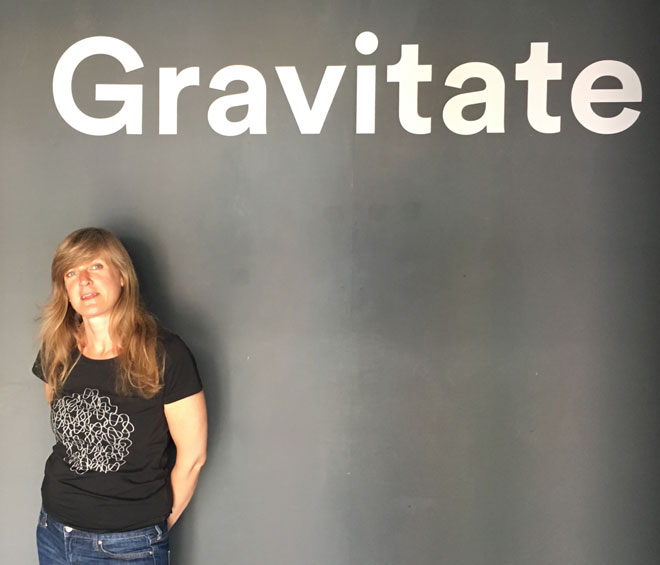
by CAROLINE MENEZES
Esther Rolinson is an artist with many talents who brilliantly combines different artistic expressions in her practice. Before she became an award-winning international artist, whose creations vary from sculptural objects to public artworks, her fascination with arts began through dance – she was interested in bodies in motion – which led her to study visual and performing arts. Since then, and along a trajectory that has already spanned more than 20 years, movement has never ceased to be an essential element in her creative process, even though she herself has never been on stage to perform, but has instead directed her professional life towards visual arts.
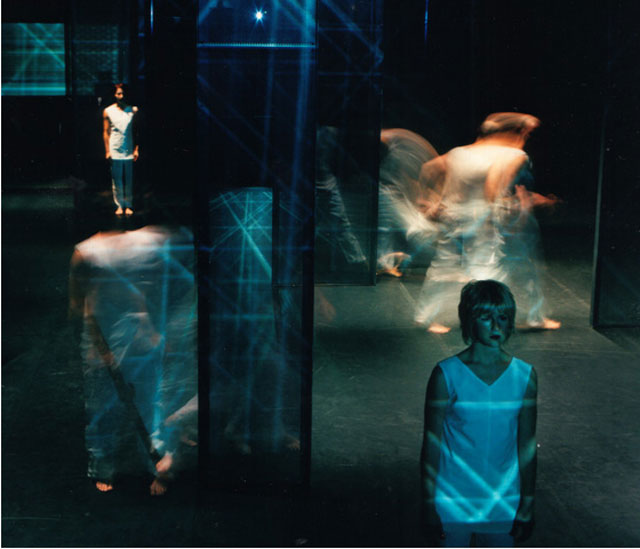
Esther Rolinson. Machine for Living (Toured 2001-3). Installation for dance performance. In collaboration with Carol Brown Dances, 10 x 10 m performance space.
At the start of her career, Rolinson, who is based in south-east England (b1971), conceived installations for dance performances such as the pieces Machine 4 Living (2001-3) and Shelf Life (1998-2002). Soon, the immersive environments that she built expanded and gained autonomy. Consequently, she was commissioned to create large artworks for buildings and public places. One can appreciate her artistic production – mostly made with lights – on the streets of different cities in England, including Brighton, Coventry and Hasting. In addition, Rolinson’s drawings and prints can also be seen in important collections, such as at the Victoria & Albert Museum.
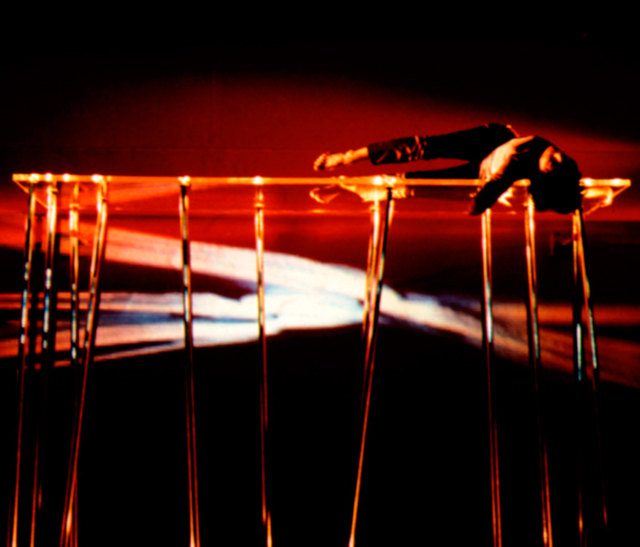
Esther Rolinson. Shelf Life (Toured 1998 - 2000). Installation for dance performance. In collaboration with Carol Brown Dances, approximate space 2.5 x 7 m.
In Gravitate, at the Watermans Art Centre in London, an exhibition in partnership with the Computer Arts Society, Rolinson has put her drawings on display, revealing that the movement that spurred her to make art in the first place can also be observed in the pencil and graphite lines in a two-dimensional shape. As highlighted by their titles, compositions such as Attraction (2016) and Expansion(2016) contain pulsating structures that appear to rise out of the paper. Surrounded by the drawings and wall-based light works, the centrepiece of the show is the installation Flown(2016), which she made with fellow British artist Sean Clark and which won the Lumen Prize in the category 3D and Sculpture Award, in 2016. It is composed of hundreds of acrylic fragments illuminated by blinking lights and assembled in an organic way that allows it to be grasped like a living being. Clark, a computer artist, used software that allows Flown to shine in response to the changes in ambiance. The concept of rules implicit in a computer program is also at the heart of Rolinson’s artistic investigation, as she explains in the following interview. Here, the multimedia artist also talks about the allure of light and its qualities as an artistic material, the significance of collaborative work and the incessant movement of her art-making.
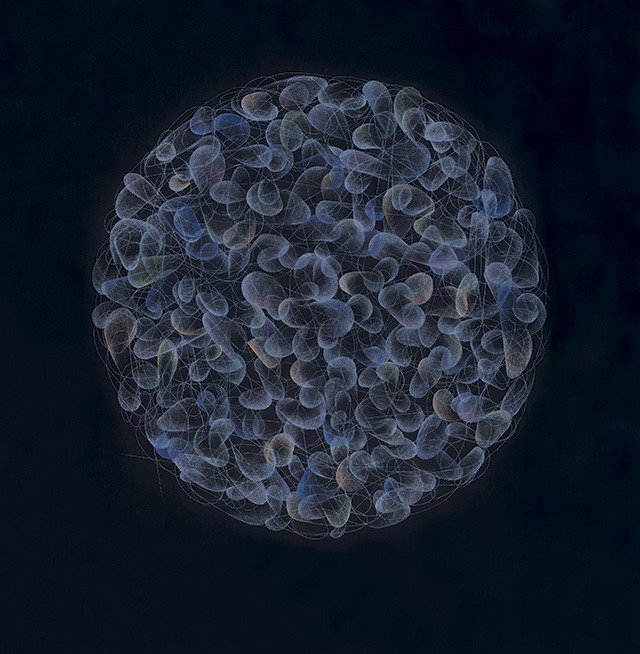
Ester Rolinson. Attraction, 2016. Drawing. Pencil crayon on inked paper, 110 x 110 cm.
Caroline Menezes: I would first like to ask you about the title of your exhibition, Gravitate. It is a beautiful and simple title that I believe is very meaningful to your work. What does it mean to you? How do you relate your artistic practice to the notions of movement, floating or suspension?
Esther Rolinson: I have chosen the title Gravitate to convey a sense of connection. I am curious about patterns and systems that underlie connections between all things. The word Gravitate expresses the possibility of attraction between things, that there might be a harmonious system in which everything, without resistance, can find its place. It is also about my own “gravitational” pull to make the works into an invitation to the viewer to come and see them. Through my drawing and installation process, I am exploring structures, movements and sensations. I often develop simple rules that I use as a method to dissociate my actions from conscious thinking. These constraints are a means of drawing patterns instinctively. It is quite a meditative process. Perhaps in very brief moments, this allows me to “float” in my own sensations, and the drawings and structures are records of that.
CM: “Gravitate” can also be interpreted as the idea of something orbiting around something else. This exhibition is the first time you have shown your drawings alongside artworks made in other media, right? What is the relation between your drawings and your more sculptural works? Which one orbits around the other? At Watermans, can you see an autonomy in the drawings that you haven’t perceived before?
ER: This is the first time I have shown the range of work in my practice, from drawing to wall-based lightworks and an installation. The work is initiated through drawing and then the physical, technical and digital aspects move forward at the same time in relation to each other. In a sense, the drawings and structures orbit around each other. I expect there will always be a relationship between physical forms and drawing. Although seeing the drawings at Watermans has given them an independence that had not been so clear before – I can now imagine making an exhibition of only two-dimensional drawings. Some pieces in the exhibition are endpoints in their own right, such as Turning (2015). Others are stages of development for something else, such as Revolve (2017), which is a plan for the installation that I will create for the Curve Theatre in Leicester in October. Connected (2015), for example, I made to be able to understand the nature of Flown and how its forms might develop. It was drawn very quickly over two hours, and I did not envisage showing it to anyone as, for me, it was purely a process of understanding. I have been pleased to have great responses to this drawing now that it is on public display.
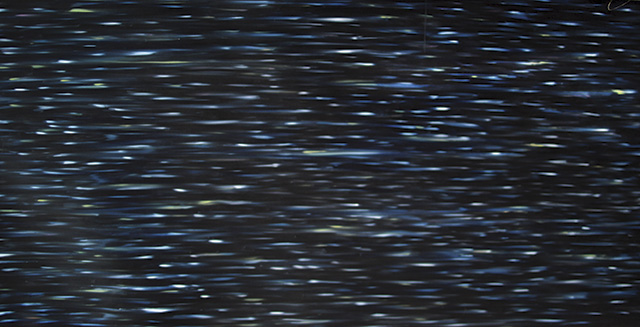
Esther Rolinson. Turning, 2015. Drawing. Oil pastel on inked paper, 150 x 66 cm.
CM: It is common sense to understand the action of drawing as a very free artistic language, in which ideas almost automatically go to the hands and are transposed on to paper. However, your drawings are highly controlled by rules that govern their basic structures. Could you explain your process for making the drawings, and how you relate them to the idea of freedom?
ER: I make drawings and objects in a range of ways; with quite tight rules, rules used intuitively and solely intuitive mark-making. I have recently been considering at length how constraints play a role in my drawing. The first sense of freedom I experienced in drawing came about, paradoxically, when I employed simple rules. Essentially, I have a very flexible set of parameters that enables that leap to automatic transposition by the hands to the paper. A rule might be something basic like “a straight line, followed by a curved line, followed by a straight line”. It may take a little time to work out what combination of marks work to express the sensation or movement I want to make. Then, when it is established, I work with it freely and quickly, and there is often a rhythm to it all. At times, I have to reflect to see if it is working and possibly become more controlled again or refine the process to guide it. The overall impression of the drawings is that they are exacting, but they are often made quite loosely. I am exploring movements, forms and sensation, and, to some extent, the drawing is like a record of the experience.
CM: Flown is not the first time that you have worked with light. Indeed, light is a frequent presence in your oeuvre. Why light? When did your fascination with this highly intangible element start?
ER: Light has an immediacy that I like. Our senses are very much affected by light; we are literally woken up by it. It has been a part of most works both in the public realm and in installations, and I’ve worked with it in many different forms, from LEDs to fibre optics and projected films and animations. In Flown, as in many other pieces, there is a relationship between light and forms. I have used it to animate an ephemeral texture. It is a material that can express movement and change and can continue to evolve so that the piece does not have a finite appearance. I am interested in making physical structures and light movements with inherent characteristics and behaviours that continue to expand and change.
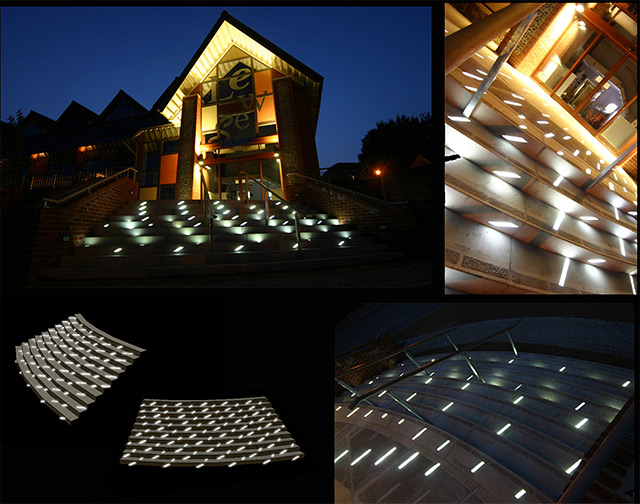
Esther Rolinson. Align, 2006. Public artwork. Animated LED channels, approximate space 4 x 6 m. Lewes Library.
CM: You have already worked with light in the public realm, streets and buildings. As, for example, the public artworks Align (2006) at Lewes Library and Trace Elements (2004) at the Electric Wharf in Coventry, which are composed of animated LED channels. Now you have a sculpture that can be adapted to be shown, as it is at Watermans, in a more intimate setting. In terms of scale or proportion, how do you relate your work to its environment or space?
ER: In the first stages, I build small-scale maquettes. These are works in their own right and a way to figure things out. However, I am interested in the physical experience and sensation and intend to make works that speak directly to the senses. This often motivates me to make pieces on a large scale. I imagine the viewer being surrounded by the structures, walking through the drawing. There is always a delicate relationship between the work and its environment. I am conscious of how the viewer will approach it, from where, at what pace, at what time of day, and so on. Working in such a variety of places has influenced me in creating structures that are extendable systems – that can be extended or reduced – so that they might be part of the motion and experience of that place.
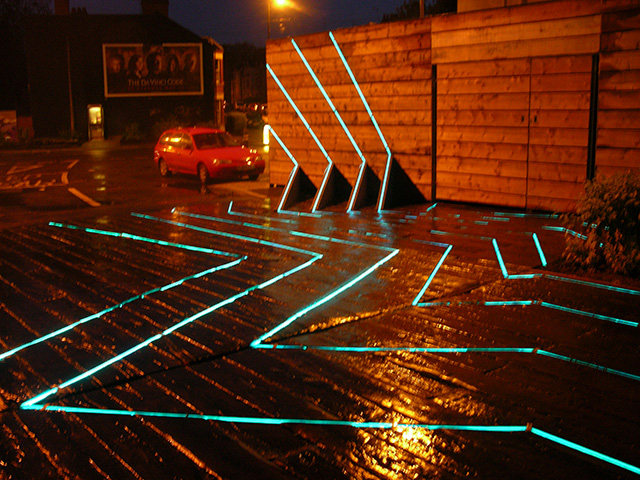
Esther Rolinson. Trace Elements, 2004. Public artwork,. Animated LED channels. Electric Wharf, Coventry. Approximate space 14 x 9 m.
CM: Flown is a collaborative work with the artist and programmer Sean Clark. What is this partnership like? Could you explain how you came to work together?
ER: Sean Clark and I came to have a collaborative practice after several years of working together. Initially, Sean was a consultant for my installation pieces Melt, Splinter and Thread, which I exhibited in 2014 in the Phoenix Arts Centre in Leicester, and then on the first version of Flown. It was through our conversations during the further development of Flown that a more collaborative approach seemed obvious. We have diverse skills, but a shared interest in the notion of connection and living systems. Our collaboration extends each other’s practice. I can see a line of development running through our combined works exploring the nature of connections and systems in drawing through to structures, technology, programming and the interconnection of artworks. We are two individual artists, and our systems of work interconnect and enrich the other while remaining their own entities. We have some shared goals and other different desired outcomes and aim to support each other to enable all those things to go ahead. Collaboration has its complexity, but is worth it as the thoughts and discussions are enlightening. I come to a greater understanding of my own work by talking with Sean. Besides the obvious sharing of skills and excitement about ideas, reflection is one of the fundamental values for me in collaboration.
CM: How do you answer the criticism that says Flownmakes a statement that is more decorative than creative?
ER: I think complexity is hidden in Flown’s apparent simplicity. It has been made through an extensive creative and collaborative process. To give you some background, Flown began with a complex textural drawing followed by a series of rule-based pencil drawings used as a method of understanding. I took the principles of the drawing into three dimensions to develop a system of parts to build an extendable structure. Then I worked intuitively with the simple construction rules to fold more than 800 individual pieces by hand in a meditative practice over 60 days. In tandem, I consulted with a team of engineers, technologists and programmers, including Sean Clark, to establish the physical parameters and programming. After its first showing at the Illuminating York light festival, I went on to collaborate with Sean to make a fully developed version. The piece can be extended to fit the space and can be made on multiple scales. It uses sensors to respond to its environment and pass information to other versions of itself and or a network of artworks. Seen as a small version, Flown’s use of technology might not be so obvious. It has subtle programming behaviours that are like a kind of breathing. Sean Clark and I both feel that digital art does not have to be about the latest technology. The digital can be embedded into the concept with computational thinking and the process of making the work. In our systems-based work, we are seeking the most elegant use of structure and technology to resolve the conceptual aims.
• Esther Rolinson: Gravitate is at Watermans Art Centre, London, until 26 July 2017.